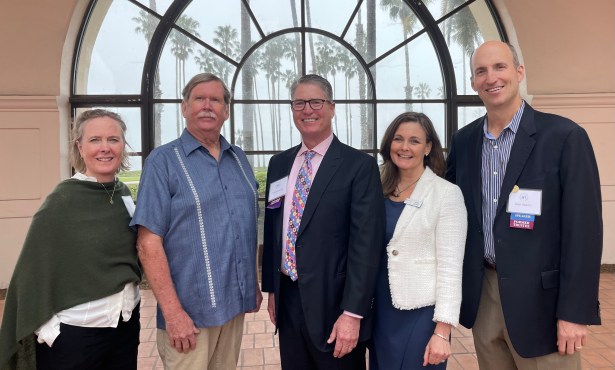Up and Out of the Creek
Desperately Seeking Eye-Shine

Holding a flashlight at eye level, I turn my head from left to right to look for glowing yellow or red eyes. I’m in a Goleta creek and will visit many more before the week is through. Walking or driving from one to the next, I slide down embankments, run my hand under leaf litter, poke the flashlight inside rotten tree stumps. I drag along every willing person I know, declaring all the while that I didn’t think finding them would be this hard.
It’s the California red-legged frog I’m looking for but I’d settle for a California newt, Western pond turtle, or two-striped garter snake. These four species are all native, and either listed as federally threatened or classified as a California species of special concern.
Remarkably, the trip some of these critters take out and to the next creek may be key to what’s keeping their population going. “So, is it fair to say that all four of these species are thriving in this region but dwindling in the rest of the state?” I ask biological consultant Lawrence E. Hunt. “Well, I wouldn’t say they’re thriving,” he replies.
Larry has been explaining that these animals are suffering huge population declines. For example, he tells me that the California red-legged frog has been reduced from at least 90 percent of its range in California. Once the commonest frog in California, the frog Mark Twain wrote about, the Celebrated Jumping Frog of Calaveras County, it is now almost extinct in the Sierra Nevadas. It’s gone in the Central Valley. The only place it’s holding its own is on the Central Coast and our coast. And south of the Ventura River, only one or two populations remain. Clarifying, he says, “Regionally, they’re in trouble, locally, they’re relatively common.”
Larry attributes this persistence to our unique geology as well as the ranching tradition. Our coastline (from Rincon to Point Arguello) is the most extensive south-facing coast in California. Its geology and tectonic history establish a unique template for biology. In particular, a homogenous mountain system with “wrinkles” in the topography allows for an extensive parallel drainage system: Many creeks in close proximity, coursing north to south. These, along with the ranch-maintained open spaces, gives native species have a chance to—persevere, if not thrive.
The streambed walls, thick with leaf litter, are the course these guys take to evacuate when necessary. You would think that water-thriving creatures would move up or down stream, especially if a creek were to run dry or become damaged. Instead, between 10 and 20 percent of the population move out. “Persons conducting radio-tagging studies … are discovering that [the animals] do not confine their movements just to the riparian corridor. Individuals routinely travel up and over hills through grassland and scrub. It appears that this type of dispersal is important in maintaining local populations,” Larry says. I contemplate death by dehydration or vehicle as the frogs search for parallel habitats; but as it turns out, even with travel distances upwards of a mile, which may take the course of four to six nights, under a veil of fog and the protection of open spaces, the animals find their way.
Larry has given me the flashlight tip. “Go out at night and keep the flashlight right next to your eyes. That way, the [animals’] eye-shine will reflect straight back to your eyes. You’ll see a lot of spiders too,” he laughs. And I do—see lots of spiders.
In some places there is a cacophony of ribbiting. But since the red-legged frog calls underwater with a low grunting, I can’t rely on the sounds for guidance. I do see green and yellow sparkles, but investigation leads me to conclude that most are spider eyes or dew drops.
I return repeatedly to El Capitan Creek specifically; a location where Larry noted tadpoles months back. Now, in the breeding season, the frogs should be full size, up to five inches. They are green with dark speckles, red-tinged legs, and identifying ridges along their back. With a glut of other creek-life sightings (including tree frogs, skunks, crazy-looking insects, and of course, the spiders) but none of the sought-after ones, I start to worry that they are more than just threatened. Maybe they’re gone. Maybe, along with the soda cans and Dixie cups, lawn care products have made their way here and have done them in.
Then, finally, my husband hands me the flashlight pointing to a place where tree roots meet water. Two yellow spots glow, then one at a time go out, then come back on again. They are the eyes of a red-legged frog and they’re blinking.
Author’s note: The information presented here is based on a formal talk (and subsequent discussion) that Lawrence E. Hunt gave at a Gaviota Coast Planning Advisory Committee meeting early this year, relating watershed principles and biological/ecological resources to the uniqueness of the Gaviota Coast. Hunt, a field biologist and herpetologist, operates Hunt & Associates Biological Consulting Services. He works and lives in Goleta and believes our coast is truly unique.



